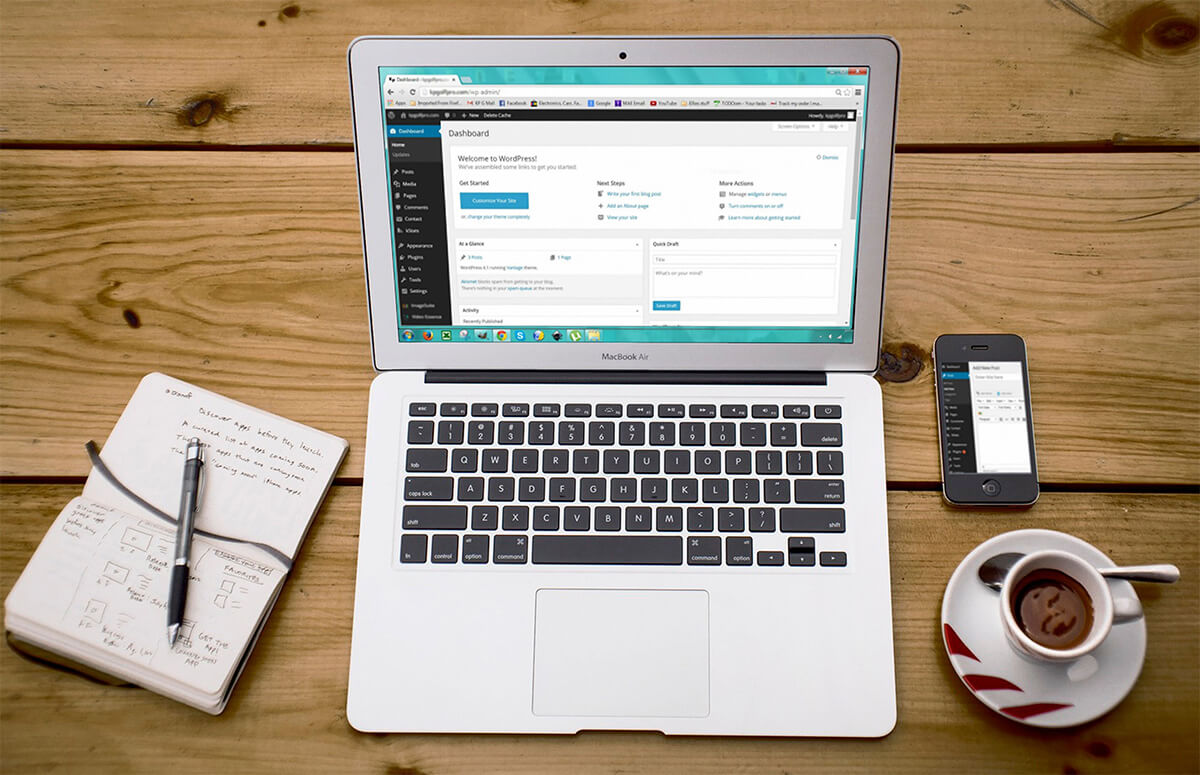
The Ultimate Web Design Checklist for Flawless Website Launch
Hey there, fellow web enthusiasts! So, you’re gearing up for a website launch and want to make sure everything goes off without a hitch? Well, you’ve come to the right place! As a team of experienced web designers and developers, we’ve been through our fair share of website launches, and we’re here to share a web design checklist for flawless website launch with you. Trust us, following these tips will help you achieve a flawless website launch and set the stage for your online success. Let’s dive right in!
Table of Contents

Pre-launch Preparation
Before the big launch, it's crucial to lay a strong foundation. This phase involves careful planning, research, and wireframing. Let's break it down:
1. Define Website Goals and Target Audience
Start by clearly defining what you want your website to achieve. Is it to sell products, provide information, or showcase your portfolio? Understanding your goals will help guide the design and development process. Additionally, identify your target audience and tailor your website’s content and design to their preferences and needs.
2. Conduct Thorough Research and Analysis
To create a website that stands out from the crowd, you need to be aware of your competition. Conduct a competitive analysis to understand what they’re doing right and identify areas where you can differentiate yourself. Additionally, delve into user experience research to gain insights into how visitors interact with websites similar to yours. This knowledge will help you make informed design decisions.
When working on an e-commerce website for outdoor gear, we discovered that the top competitors had simplified and streamlined checkout processes. We took note of their strategies and incorporated a hassle-free, one-page checkout system into our client’s website, resulting in increased conversions.
3. Plan Website Structure and Sitemap
The organization of your website plays a crucial role in user experience. Plan a clear and logical website structure that makes it easy for visitors to navigate and find what they’re looking for. Create a sitemap that outlines all the pages and how they are interconnected. This will serve as a roadmap during the design and development stages.
4. Create Wireframes and Mockups
Now it’s time to bring your ideas to life visually. Develop wireframes and mockups that represent the layout, structure, and functionality of your website. These visual representations will help you refine the design and gather feedback before diving into the development phase.
5. Choose a Reliable Web Hosting Provider
Selecting the right web hosting provider is crucial for website performance and reliability. Look for providers with excellent uptime, robust security features, and responsive customer support. A reliable hosting provider ensures your website is accessible to visitors and provides a seamless browsing experience.
We once had a client who opted for a cheap hosting provider, and their website experienced frequent downtime and slow loading speeds. It was a lesson learned that investing in quality hosting is essential for a smooth website launch and user satisfaction.

Content Creation and Optimization
Great content is the backbone of any successful website. Pay attention to the following aspects when creating and optimizing your website's content:
1. Develop Engaging and Relevant Content
Craft compelling and relevant content that captivates your audience. Whether it’s the homepage, product descriptions, or blog posts, ensure your content is well-written, concise, and speaks directly to your target audience. Focus on showcasing the unique value you offer and addressing their pain points.
2. Optimize Content for Search Engines
To increase your website’s visibility in search engine results, optimize your content for relevant keywords. Conduct thorough keyword research to identify the terms your target audience is searching for. Incorporate these keywords naturally into your headings, subheadings, and body text. Additionally, implement meta tags and descriptions to improve your website’s click-through rate.
When optimizing a client’s website for search engines, we noticed that a specific blog post consistently received high traffic. By optimizing it further and expanding on the topic, we were able to significantly increase organic traffic and attract more leads.

Responsive Design and Cross-Browser Compatibility
With the increasing use of mobile devices, it's crucial to ensure your website looks great and functions flawlessly on various screen sizes and browsers. Here's what you need to consider:
1. Ensure Mobile-Friendly Design
Mobile responsiveness is no longer an option; it’s a necessity. A responsive design adapts seamlessly to different screen sizes, providing an optimal user experience across devices. Pay attention to touch-friendly elements, legible fonts, and intuitive navigation on mobile devices.
2. Test Website on Different Browsers and Devices
Your website may look perfect on one browser but may have layout issues on another. Test your website across different browsers (Chrome, Firefox, Safari, etc.) to ensure consistent appearance and functionality. Additionally, check how your website performs on various devices, including desktops, smartphones, and tablets.
We once had a client who was excited about their new website until they opened it on their preferred browser and realized the layout was all wonky. We quickly discovered it was due to a compatibility issue with that particular browser. After some adjustments and thorough testing, we made sure the website looked great across all major browsers.

User Experience and Accessibility
Delivering an exceptional user experience is key to keeping visitors engaged and driving conversions. Focus on the following aspects to provide a user-friendly and accessible website:
1. Create Intuitive and User-Friendly Navigation
Navigation should be easy to understand and use. Ensure your menus are logically organized, and important sections are easily accessible. Incorporate breadcrumbs and search functionality to help users find what they’re looking for quickly.
2. Optimize Website Speed and Performance
Website speed plays a vital role in user satisfaction and search engine rankings. Optimize your website’s performance by minifying CSS and JavaScript files, compressing and optimizing images, and leveraging caching and content delivery networks (CDNs).
We once worked on a website that took forever to load due to large, unoptimized images. After optimizing the images and implementing caching techniques, the website’s loading speed improved significantly, resulting in a better user experience and increased conversions.
3. Conduct Thorough Usability Testing
Usability testing helps identify any issues or friction points that may hinder the user experience. Test forms, links, and interactive elements to ensure they function as expected. Additionally, check for broken links and error messages throughout the website.
4. Ensure Accessibility for Users with Disabilities
Make your website accessible to all users, including those with disabilities. Ensure proper color contrast, use alt tags for images to provide text alternatives, and incorporate features that assist screen readers. By considering accessibility, you create an inclusive experience for a wider audience.
During an accessibility audit for a client’s website, we discovered that some important images lacked alternative text. By adding descriptive alt tags, we not only improved accessibility but also enhanced the website’s search engine optimization (SEO).

Testing and Quality Assurance
To ensure a flawless website launch, thorough testing and quality assurance are vital. Let's explore the steps involved:
1. Conduct Comprehensive Testing
Testing is crucial to identify and resolve any issues before the launch. Perform functionality testing to ensure all features and interactive elements work as intended. Conduct browser compatibility testing to verify that your website appears and functions correctly across different browsers. Test mobile responsiveness to ensure optimal display on various devices. Lastly, perform performance testing to assess loading speed and overall website performance.
2. Debug and Fix Any Issues
During testing, you may encounter bugs or errors that need to be addressed. Validate your HTML and CSS code to ensure it adheres to industry standards. Fix any broken links or error messages that may hinder the user experience. It’s essential to resolve these issues before launching your website to provide a seamless browsing experience.

SEO and Analytics Integration
To maximize your website's visibility and track its performance, implement SEO best practices and integrate analytics tools:
1. Implement SEO Practices
Optimize your website for search engines by using descriptive URLs, creating an XML sitemap, and implementing structured data markup. These practices help search engines understand your website’s content better and improve its chances of ranking higher in search results.
2. Set Up Web Analytics Tools
Install a web analytics tool like Google Analytics to gain insights into your website’s performance. Track metrics such as website traffic, user behavior, and conversions. These analytics provide valuable data for optimizing your website and making informed business decisions.

Security and Data Protection
Protecting your website and user data is crucial in today's digital landscape. Implement the following measures for enhanced security:
1. Implement SSL Certificate for Secure Browsing
Secure Sockets Layer (SSL) encryption ensures that data transmitted between your website and visitors’ browsers remains secure. Install an SSL certificate to enable HTTPS encryption and provide a secure browsing experience for your users.
2. Set Up Regular Backups
Regularly backing up your website is essential to protect against data loss. Set up automated backups to ensure you have a recent copy of your website’s files and databases in case of emergencies or unforeseen events.
3. Protect Against Spam and Malware
Implement spam protection measures such as CAPTCHA verification on forms to prevent spam submissions. Additionally, use security plugins or firewalls to safeguard your website against malware and hacking attempts.
4. Ensure Compliance with Data Protection Regulations
Depending on your location, you may be subject to data protection regulations such as the General Data Protection Regulation (GDPR). Ensure that your website is compliant with these regulations by implementing privacy policies, cookie consent banners, and user data protection measures.

Final Checks and Launch
Before launching your website into the online world, make sure to complete the following final checks:
1. Cross-Check All Content and Links
Review all website content, including text, images, and multimedia, to ensure accuracy and consistency. Double-check that all internal and external links are working correctly and lead to the intended destinations.
2. Validate HTML and CSS Code
Run your website’s HTML and CSS code through validators to identify any coding errors or issues. Valid code improves website performance and ensures compatibility across different devices and browsers.
3. Test Contact Forms and Other Interactive Features
Test all contact forms, sign-up forms, and interactive features to ensure they are functioning properly. Verify that submitted forms are being delivered to the correct recipients and that automated responses are working as expected.
4. Conduct Final Performance Optimization
Optimize your website’s performance one last time before launch. Fine-tune loading speed, optimize images and scripts, and ensure all caching and compression techniques are in place.
5. Backup Website Files and Databases
Create a final backup of your website’s files and databases. Store them securely in a separate location, ensuring you have a copy to restore from in case of any unforeseen issues during or after the launch.
6. Launch the Website!
Congratulations, it’s time to launch your website! Make it live and share it with the world. Celebrate your hard work and efforts!

Post-launch Activities
The journey doesn't end with the website launch. Implement the following post-launch activities to ensure ongoing success:
1. Monitor Website Performance and Analytics
Keep a close eye on your website’s performance using web analytics tools. Track metrics such as traffic sources, user engagement, and conversions. Use this data to make informed decisions and continuously optimize your website for better results.
2. Continuously Update and Optimize Content
Regularly update and refresh your website’s content to keep it relevant and engaging. Stay updated with industry trends and incorporate new information as needed. Optimization is an ongoing process, so keep refining your content based on user feedback and analytics insights.
3. Engage with Users and Collect Feedback
Encourage user engagement by providing opportunities for feedback, such as contact forms, surveys, or comments sections. Listen to your users’ feedback and make improvements based on their suggestions. Engaging with your audience builds trust and fosters long-term relationships.
4. Regularly Backup and Update Website Software
Continue to perform regular backups to protect your website from potential data loss. Stay up to date with software updates, including content management systems, plugins, and themes, to ensure your website remains secure and optimized.
You Did It!
Phew! That was quite a journey, but you made it! By following this ultimate web design checklist, you’ve equipped yourself with the necessary tools and knowledge to ensure a flawless website launch. Not every site is the same but by following these basic steps you will save yourself a lot of stress. Remember, meticulous planning, thoughtful design, and thorough testing are the key ingredients to success. Now go ahead, launch that website, and watch it flourish in the online world. Best of luck on your web design adventure!





